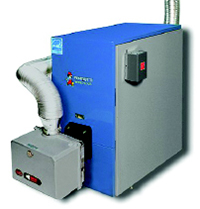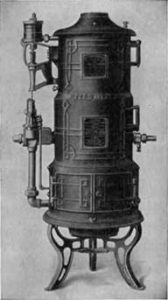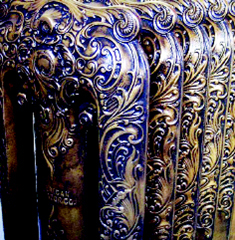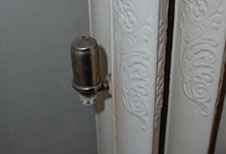We never think about our home heating systems until that first cold day in November, when we flick on the thermostat, only to find that the furnace doesn’t fire up.

Then we contact our service technician, who is slow to return our call, as he or she is booked solid with everyone else who has just discovered that their system is acting strangely. Late summer and early fall are the best time to give a little love to your heating system; it’s easy and less expensive to have something serviced then, but just as importantly, you can perform a lot of the minor maintenance yourself, before you’ve wasted fuel or spent a chilly night or two waiting for help.
All Duct Up (or, The Duct Stops Here):
If you have a forced hot air system, you can improve its efficiency by cleaning the ducts in every room. There are professional companies that will clean out the entire system, but you can accomplish quite a bit on your own by simply lifting up the grates and vacuuming as much as possible with that little brush attachment on your vacuum cleaner or even better, a shop-vac.

It’s a Wrap:
This is also a great time to give the ducts in the cellar or attic a quick once-over. In an older home, they may not have been insulated, and you can wrap them with insulation specifically intended for this purpose. This means that more of the heat gets to the rooms instead of your basement. You can also seal any leaks in the ducts with, yes, duct-tape, although the metallic tape works much better than the cloth variety.
Grates on Me:
Most heating grates or registers have a sliding mechanism that allows you to adjust the amount of heated air entering each room by restricting airflow with louvers. Rooms near the plenum (the main shaft coming out of the furnace) are typically warmer, while those far away, such as second or third floor bedrooms, are often colder. By closing the registers slightly in the warmer rooms, you can redirect additional heat to the colder ones for a more consistent overall house temperature.
Filtered:
Forced hot air furnaces have filters. These are usually located at the cold air returns (where fresh air is sucked back into the furnace in readiness to be heated) and are inexpensive and are easy to replace; they simply slide out. Replace these in October and then monthly during heating season; they trap dust and dirt and prevent it from entering the furnace, which will impair the furnace’s efficiency greatly.
 Radiators, care and maintenance:
Radiators, care and maintenance:
Many homes had steam radiators added around 1910, as the gravity hot air systems became outdated. These work well with a little care, but you can get loud “hammering”, which is caused by air bubbles pushing up through the pipes as condensed steam blocks their path. If this happens in your home, try placing a small wedge of wood under the feet of the radiator that are farthest from the pipe. This slight incline will allow the condensed steam to run back down the risers.
Valves:

Steam systems also have valves at the far end of the radiator; these are usually chrome (unless they’ve been painted over) and are adjustable. Valves allow you to build up more pressure, and thus heat, in colder rooms while allowing warmer rooms to use less heat. If they are old and not functioning properly, they can be replaced by using a wrench.
The “A” Word:
In many older homes, steam pipes are insulated with a wrapping of asbestos; it’s a thick, white or gray covering. Don’t panic; while airborne asbestos is a serious health hazard, existing asbestos pipe insulation can be contained with an over-wrapping that you can apply. It’s always better to encapsulate asbestos, as removing it often puts even more fibers in the air. The covering is like a plaster bandage; sheets are soaked and wrapped around the asbestos, which prevents it from becoming airborne if it deteriorates. Asbestos can also be covered with plastic sheeting and sealed. This can be done by the homeowner if the insulation is in good condition; if it’s hanging off in strips, professional help will be required.
Calling in the Pros:
There are some that other tasks the average homeowner should leave to the professional, namely fiddling with the inner workings of a furnace or boiler. The heating technician will clean any assemblies involved with combustion and make sure all the mechanisms and safety devices are functioning properly. A regular service call will often find a potential problem now, and not on a Christmas weekend, when you’d have to order emergency service and perhaps wait for parts.
SIDEBAR 1
Audits aren’t necessary bad things:
Many states offer free or low cost energy audits, where a skilled consultant will visit you in your home and point out things both small and large that will help you save energy. He or she will look at your heating system, the amount of insulation in your house and the condition of your doors and windows. Windows and doors don’t always have to be replaced; your consultant will show you how to weather-strip them properly so that you can preserve the historic appearance of your home and while saving energy.
SIDEBAR 2
Love Me, Love My Radiators
With a little care, those vintage cast-iron radiators will not only warm your home, but preserve an essential part of its historic interior.
There’s no need to replace properly functioning old radiators, especially if you’re fortunate enough to have the more ornate models. Aside from leveling them and ensuring the valves are working, they’ll just need an occasional coat of paint. Treat radiators like any other metal surface by scraping, priming and painting. The most popular colors are metallic gold or silver, but many folks like to have them match the wall shade, which makes the radiator recede visually into the background. If your radiator leaks on needs fins added or removed, there are companies like www.allaboutradiators.com offer a mobile service. They will remove, repair, sandblast and finish your radiators for you.
Dan Cooper is a well-known author, and has published over a thousand articles on the subjects of antiques, architecture, preservation and historic interior design. His first book, New Classic American Houses, was published by The Vendome Press. Dan is also President and CEO of Cooper Lace, has designed and sold historic lace curtains for twenty four years, providing them to private homes, museums and film sets. Dan is recognized as a leading authority on the subject of historic carpeting.



